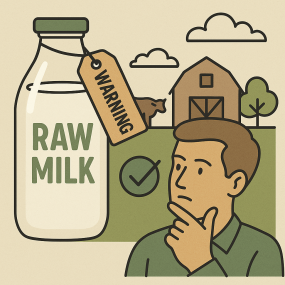Risks are real
Public-health authorities have long documented foodborne outbreaks tied to raw dairy. CDC summaries and recent MMWR reports show recurring clusters of Campylobacter, STEC (E. coli), and Salmonella linked to raw milk and raw-milk cheeses. Risk is real, particularly for kids, pregnant people, the elderly, and the immunocompromised. That’s precisely why labels and point-of-sale counseling matter. Private certification and testing firms should be free to offer a “Seal of Approval” in the same way that organic and non-GMO seals exist outside the state apparatus. Farmers will want to earn trust and will be rewarded with repeat sales. Bad actors with unsafe conditions for their products will lose. That is the free market at work!

Bans ignore plausible benefits
There’s credible (though not definitive) evidence that early-life consumption of raw “farm milk” correlates with lower rates of childhood asthma, atopy, and respiratory infections. Large European cohorts (GABRIELA, PARSIFAL, PASTURE) and meta-analyses point to protective associations related to whey proteins or microbial exposures. On balance: potential upside signals exist, especially in children, but you need to be mindful of potential hazards.
PubMed+2PubMed+2JACI OnlineScienceDirect
We don’t expect everyone to do their own research, but you don’t need to read a medical treatise to know that there is potential good and bad in everything we consume. Fake news isn’t confined to the MSM. For example, raw milk is not better for the lactose intolerant.
Where Ohio law stands (and what’s actually proposed)
Today, retail sale of raw milk to consumers is illegal in Ohio; access typically runs through herd-share arrangements and back alley transactions (like your old week dealer). A new bill, HB 406 (“Farm-to-Consumer Access to Raw Milk Act”) would legalize on-farm sales with guardrails such as licensing, liability waivers, and regular pathogen testing; off-farm retail would remain prohibited. This is deemed a reasonable middle path dreamed up by the milquetoast bureaucrats in the General Assembly. Republicans want to appear committed to individual rights and liberty so long as the infectious paternalism that is rampant in the GOP is not diminished.
The libertarian case: permission, not protectionism
John Stuart Mill’s harm principle draws a line between self-regarding choices and actions that directly harm others. Buying raw milk is a paradigmatic self-regarding choice when labeling is clear and producers aren’t defrauding anyone. Friedrich Hayek warned that centralized one-size-fits-all rules suppress local knowledge; letting consenting adults transact with transparent information respects decentralized discovery. Robert Nozick’s self-ownership framework underscores that competent adults may assume risk provided others aren’t coerced or deceived. In short: inform, don’t infantilize.
A sensible Ohio framework
If lawmakers want both liberty and safety, couple legalization with:
● Plain-language warnings at point of sale and on containers is the maximum involvement government should have. There is higher risk for some groups consuming this product and we are not responsible for potential harm.
● Voluntary disclosure of monthly pathogen test results online and on-farm, so buyers can comparison-shop on safety. If the state wants to set up a website for people to see where to buy raw milk and the self-reported testing, that would be great.
● Civil liability & contract clarity – A waiver is fine so long as fraud and gross negligence remain actionable. Having private testing firms bear some responsibility for their results is essential.
● Age-restricted sales – Adults can make their own decision and parents can decide for their families consistent with many food-risk contexts.
These measures align with the evidence that outbreaks do occur, while respecting competent adults’ agency.
Bottom line
Ohio should legalize on-farm sales of raw milk with robust transparency, not a paternalistic ban.
Adults already make informed choices about sushi, undercooked steak, and raw oysters; milk deserves the same treatment: warn clearly, test regularly, publish results, and let people choose.
Sources
CDC Public Health Law Program: research roundup on raw-milk outbreaks and legal availability. CDC
● 2024 CDC/State survey on responding to unpasteurized-milk outbreaks (discussion of rising links to illnesses). CDC Stacks
● 2025 MMWR: Salmonella Typhimurium outbreak associated with raw milk/cheese (late 2023–2024). CDC
● GABRIELA study (JACI): farm/raw milk and lower childhood asthma/atopy; whey proteins implicated. PubMedJACI Online
● PASTURE birth cohort (JACI): early raw milk linked to ~30% fewer infant respiratory infections/fever. PubMed
● Meta-analysis corroborating early-life protective associations on asthma. ScienceDirect
● Systematic review on pasteurization and allergy outcomes (benefit signals but potential confounding). PubMed
● RCT: raw milk does not reduce lactose-intolerance symptoms. PMC
● Ohio legal status & herd-shares (Ohio State Farm Office) and HB 406 bill page + recent coverage. farmtoconsumer.orgfarmoffice.osu.eduOhio Legislaturedayton-daily-news
